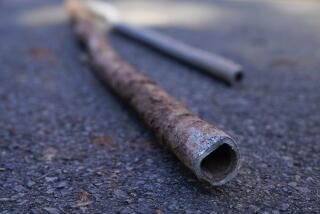Science/Medicine : Lead Leads to Artifact Origin
- Share via
Scientists at the National Bureau of Standards have come to the aid of archeologists and art historians seeking to determine the origins of ancient artifacts and art objects.
The scientists have found that the ratios of different atomic types of lead--called lead isotopes--present in metal objects are a distinctive “signature” of the locality where such objects were made.
“Amounts of three lead isotopes--lead 206, 207 and 208--formed in nature as stable end products of uranium and thorium decay are discernably different in most geographic locations,” the bureau reported. When these three elements are compared to a stable, fourth lead isotope, lead 204, scientists can read “a signature characteristic of a particular lead deposit or mine location.”
Most recently, bureau scientists used the technique to help collection experts at the Arthur M. Sackler Gallery of Oriental and Near-Eastern Art in Washington.
The researchers were able to sort out origins of bronze vessels made in China between 2500 and 221 B.C. Chinese artisans routinely added lead to bronze alloys to make it easier to cast.






